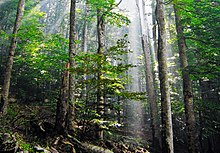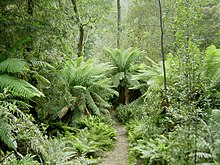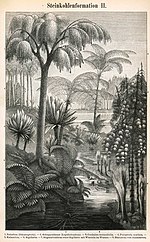Forest






A forest is a piece of land with many trees. Forests are important and grow in many places around the world. They are an ecosystem which includes many plants and animals. Many animals live in forests and need them to survive.
Temperature and rainfall are the two most important things for forests. Many places are too cold or too dry for them. Forests exist from the equator to near the polar regions, but different climates have different kinds of forests. In cold climates conifers dominate, but in temperate zone and tropical climates forests are mainly made up of flowering plants. Different rainfall also makes different kinds of forest.
There are no forests in deserts, just a few trees in places where their roots can get at some underground water. There's quite a lot of water beneath the Sahara desert, and also beneath the Australian desert areas. The general term for this is "groundwater".
Biomass[change | change source]
Forests contain 80% of the Earth's plant biomass. The total live biomass on Earth is about 550–560 billion tonnes C.[1]
Forest biomes[change | change source]
The three major forest biomes are coniferous forests, deciduous forests, and tropical rain forests. More than half of the world's forests are found in only five countries (Brazil, Canada, China, the Russian Federation, and the United States of America). More forests (45 percent) are in the tropics than any other climates.
Coniferous forests[change | change source]
Coniferous forests stretch across Canada, Alaska, Northern Asia, and Northern Europe. Their main trees are evergreen conifers which produce seeds in cones.
The weather during the winter is cold, but when snow melts in the spring, some parts of the forest become swamps. There are not many different types of trees in coniferous forests because of the cold weather, and the poor soil. Fallen branches, needles, and dead animals do not decay as fast as in warmer regions. This is why the soil in coniferous forests is not very fertile. Also, only those trees that have adapted to cold weather and poor soil can survive. These trees have flexible branches that support heavy snowfalls. Less water evaporates from their leaves because of the shape of their needles.[2]
Many coniferous trees shade large parts of the soil below them, which keeps many plants from growing on the forest ground. Some animals that live in the coniferous forests are pine martens, deer, bears, caribou, moose, several owls, crossbills, and red squirrels.
Deciduous forests[change | change source]
Deciduous forests mostly grow in the temperate zone of North America, Europe and Asia. They have a moderate climate during the spring, summer, autumn (fall) and winter, with rainfall of at least 500mm a year. Summers are warm and winters are cold, but not as cold as the northern coniferous forests. In the winter, snow covers the ground and the deciduous trees and plants lose their leaves. The decaying leaves help make the soil rich in nutrients. Many insects, spiders, snails, and worms make their homes in this rich soil. Wild flowers and ferns grow almost everywhere in the spring. New leaves capture the energy of the sun and sprout before the tall trees shadow them.[3]
During the winter, many birds migrate to warmer climates. Many small animals hibernate or aestivate, in other words, they slow down their metabolism and sleep or stay in their burrows. Some of the other animals just slow down their metabolism and eat food they stored during the summer and fall months. The trees in winter are bare, but with the coming of spring, leaves sprout, birds return, animals are born, and all the forest animals get busy with their lives. Animals that we may see or hear in this biome include bears, deer, raccoons, otters, beavers, foxes, frogs, squirrels, snakes, salamanders, and birds such as woodpeckers, robins (European or American), owls, blue jays and the small birds usually called tits (family Paridae).
Some deciduous forests grow in tropical places that do not have a winter but do have a wet season and a dry season.
Rainforests[change | change source]
Tropical rainforests grow in South America, the Congo, Indonesia and some nearby countries, Hawaii, and north eastern Australia. Tropical rainforests are well named, as it rains here on about half the days. The only season in a tropical rain forest is summer, so plants grow for all 12 months of the year. Trees are tall and thick in the rain forest and they grow so close together that they form a big umbrella of greenery called a canopy. This blocks out most of the sunlight. The air is muggy as it filters through the dense canopy cover of the trees. The light that filters through this tree cover is dim and green. Only along river banks and in places that have been cleared does enough sunlight allow plants to grow on the forest ground.
Millions of species of plants and animals live in the world's tropical forests. Life in the rain forest exists at different levels or layers in the trees. Each layer has a name, such as 'emergent', 'canopy', 'understory', and 'forest floor'. Animal life is found on all levels.
History of forests[change | change source]

The first forests on Earth were about 380 million years ago), in the later Devonian period. Archaeopteris grew to about 10 meters tall (33 feet). The plant was rather fern-like, with deciduous fronds which dropped onto the forest floor. Streams running through the forest picked up fronds, which perhaps stimulated freshwater fishes. Wattieza was an even earlier plant which has been claimed as the "first tree". They were also fern-like, reproduced with spores and grew in groups together.
Forests were widespread biomes in the Carboniferous period. The earlier part is called the Mississippian, and the later part is known as the Pennsylvanian in North America.
Related pages[change | change source]
- Tropical rainforest
- Peat swamp forest
- Congo rainforest
- Cloud forest
- Temperate rainforest
- Deforestation
References[change | change source]
- ↑ Bar-On YM, Phillips R, Milo R (June 2018). "The biomass distribution on Earth". Proceedings of the National Academy of Sciences of the United States of America. 115 (25): 6506–6511. Bibcode:2018PNAS..115.6506B. doi:10.1073/pnas.1711842115. PMC 6016768. PMID 29784790.
- ↑ Vogt, Kristina A, ed. 2007. Global societies and forest legacies creating today's forest landscapes. In: Forests and Society: sustainability and life cycles of forests in human landscapes. CABI. pp. 30–59. ISBN 978-1-84593-098-1
- ↑ In a deciduous forest there are always places where the sunlight reaches the ground.
